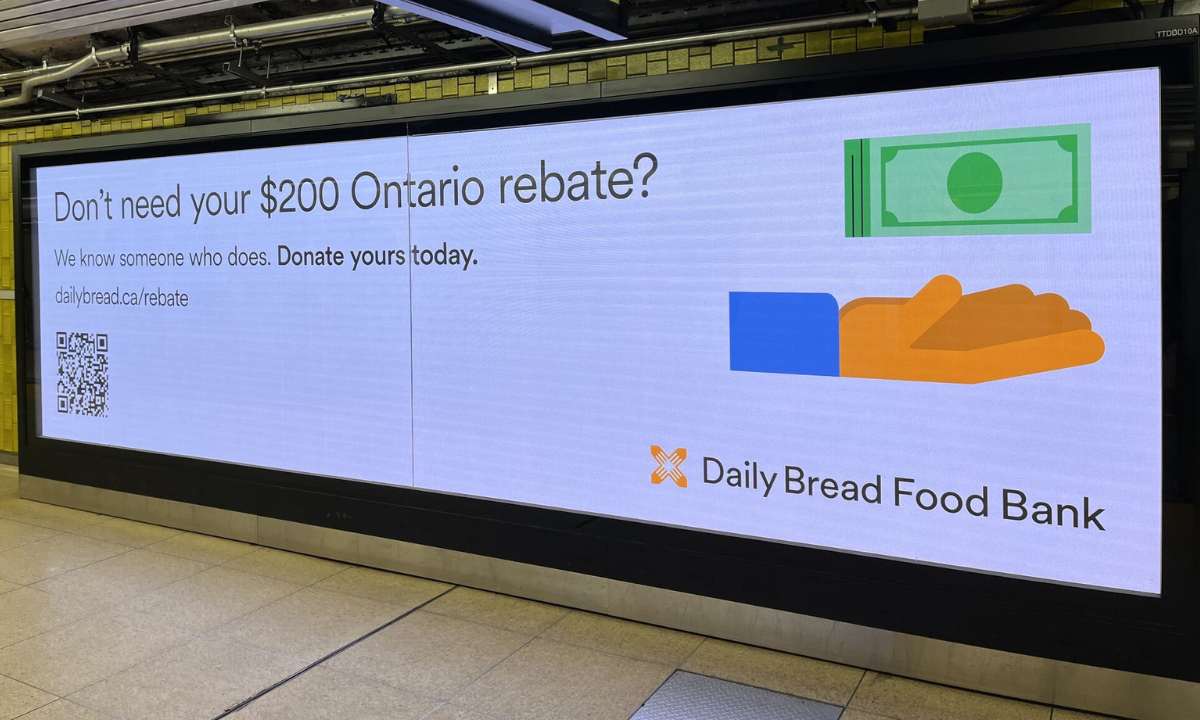How a QR code campaign generated $250,000 for Toronto food bank Daily Bread
Why It Matters
By spinning up a low-cost fundraising campaign informed by a change in a local context, Daily Bread was able to generate additional capital – crucial as demand on its network of food banks continues to rise.

Every taxpayer in Ontario – and their children – is set to receive a $200 rebate to help with the rising cost of living in the province. For some, the cheques have already begun to trickle through.
For others who might not need the extra cash injection, another offer is on the table.
People can now donate their rebate directly to Daily Bread Food Bank by scanning a QR code. The non-profit works with 129 member agencies and 205 food programs across the city of Toronto.
This campaign alone has generated more than $250,000 in donations already, said CEO Neil Hetherington. One of the ads, for example, was placed in Toronto’s Billy Bishop Airport, a busy commuter terminal downtown.
Knowing that these rebates were going to pour $3 billion back into the economy, the Daily Bread team wanted to respond, he said.
“There was a bit of a concern about whether we were being opportunistic,” he said. “And I said: ‘Yes, we are.’
“We’re supposed to be creative [but] there was a real concern about whether or not there would be backlash.”
The number of families in Toronto relying on food banks continues to worsen: only a few weeks ago, Mayor Olivia Chow and the Toronto City Council declared a city-wide food emergency. One in every ten families in the city now relies on a food bank, and a quarter of households in Toronto reportedly experienced food insecurity in 2023.
Daily Bread’s network of food banks has had to step up their operations immensely: the charity delivered 50 million meals in 2024, a fivefold increase from 2020.

Keeping fundraising flexible
According to Hetherington, this campaign’s success is due to simple copywriting—“Don’t need your $200 Ontario rebate? We know someone who does”—and the ease and speed with which donations can be processed.
Daily Bread also committed to a low-spend campaign: for every $1 they spent, they generated $20 in donations, Hetherington added.
Amid the $200 rebate donations, there was also one major gift of $10,000 – from a donor who specifically appreciated Daily Bread’s “foresight.” said Hetherington. Many donors have also shifted from a one-off gift to a monthly contribution through this initiative.
The campaign is designed to collect as little information as possible, but the data they do have is a significant asset, Hetherington said.
Addresses, in particular, can help the charity design more targeted appeals. In Daily Bread’s case, they work with market research company Environics Analytics to categorize donors into marketing segments based on their addresses and postal codes.
The fundraising team was able to pivot on short notice because of how they developed their business plans, Hetherington added. “They have to be developing for 80 per cent, not 100 per cent, because I want them to have room in the gas tank for something new.
“Is this all stretchy goals, or have you left room to be able to do the unknown?”

